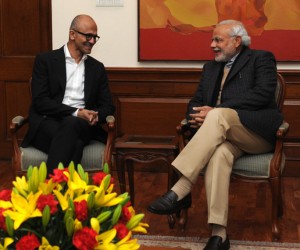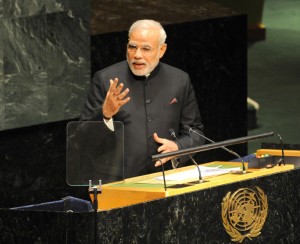
Digital India: The Realities and challenges ahead


While Prime Minister Narendra Modi’s Digital India initiative has been much publicised and promoted within the country as well as abroad and has managed to attract commitments worth billions of dollars from Corporate technological giants across the globe, the ground realities present and the major roadblocks and hurdles lying in the path need to be considered and assessed in order to measure the real progress being made in materialising the Prime Minister’s vision.
According to a recent report titled State of Broadband Report 2015, released by the United Nations (UN) Broadband commission, there is a sharp decline in the global growth rate of Broadband usage and roughly 4 billion people which constitute 57 percentage of the world population, still don’t have access to internet.
The report states that India’s fixed broadband ranking has fallen to 155 from the 133rd position it had held in 2013. When it comes to overall broadband usage which is inclusive of both fixed connections as well as mobile network based connections, the picture is slightly encouraging with India moving up to the 136th position from 142nd in 2014. But this ranking is way behind those of countries like Syria, Zimbabwe and Ghana. Mobile phone based internet usage in India has risen from 3.2 percent in 2013 to 5.5 percent in 2015.
The Digital India initiative is a massive and progressive national project started by Prime Minister Modi in July 2015 and the fundamental aim is to introduce e-Governance in India and also make the country a digitally empowered one. The main aspects of DI are creation of Broadband highways, universal access to phones, e-Governance, e-Kranti which denotes electronic delivery of services and total indigenization of all the Electronics manufacturing with net zero imports. It also encompasses some Early Harvest or short timeline implementation projects like Biometric attendance for all central government offices in Delhi to begin with, secure e-mail within Government and introduction of Wi-Fi in all universities. Thus the full implementation of the DI initiative will help India take the giant leap of transformation in to a digitally empowered knowledge economy and also help leverage the globally acknowledged Indian IT competence for the benefit of its entire population.
The DI project will be overseen by the Bharat Broadband Network limited which is involved in the implementation of the National Optical Fiber Network (NOFN) project which was started in 2011 by the then UPA government to provide broadband connectivity to over 2 Lakh Gram Panchayats (Village administrative councils) at a cost of around 20,000 Crore Rupees or 3 billion USD.
While ambitious initiatives on a massive sale like the DI that aims at empowering the society from the grassroots level are most welcome and much needed at his hour, the quality and speed of Internet connections available even in big metros like Mumbai, Delhi and Chennai are a cause of serious concern according to most analysts. The World’s largest Content Delivery Provider (CDN), US based AKamai Technologies had released its State of internet report for the first quarter of 2015 in June and according to it, the average network speed available in India is a mere 0.8 Mbps while the global average is 5 Mbps. South Korea’s national average speed was found to be an enviable 13.7 Mbps. This figure about India’s national average only presents the sorry state of affairs in the (India’s) crowded Internet Service Provider (ISP) marketplace. Here, still the definition of broadband is any network with a download speed that is equal to pr more than 512 Kbps, whereas the US Federal Communications Commission (FCC) has updated its broadband benchmark speeds to 25 Mbps. Earlier this year, Telecom Regulatory Authority of India (Trai) chairman Rahul Khullar had said that India was one of the worst connected countries in the world by any metric. Trai has criticized the dismal state of broadband in India and has called for a complete overhaul of the broadband scenario and structure in India. It attributes the current poor state to various issues like infrastructure (Network towers, Optical fibre and back haul spectrum), Right of way (Row) issues and spectrum management. Trai has also lamented about the multi-institutional structure that’s overseeing the building of NOFN. NOFN that was initiated in 2011 is estimated to have connected less that 10% of the targeted 20 Lakh gram Panchayats so far. Trai attributes the multi-layered decision making structure for the tardiness and hamstringing of this project. Trai has also come up with recommendations to improve the Broadband networks like turning the Wireless Planning and Coordination Wing of the Department of Telecommunications- custodian of all wireless radio waves in the country, into an independent statutory body reporting to the Parliament or any other existing statutory body. It also recommends the introduction of spectrum audits to check for unused spectrum if any, across all national organizations like Railways, Defence forces and the National Television Broadcaster, Doordarshan in the coming months. Khullar added that when compared to most other developing countries, India has only 40 % of the spectrum allocated for usage and the current situation can be improved either by allotting more spectrum or by using the existing spectrum in a more efficient manner.
According to another Trai report released in January, there were 82.22 million broadband users in the country and the top 5 service providers who cumulatively enjoy 87% of the market share are the state owned Bharat Sanchar Nigam Ltd (BSNL) with 18.7 million subscribers, Bharti Airtel with 18.17 million, Vodafone India with 15.61 million, Idea Cellular with 12.26 million and Reliance Communications with 6.77 million. BSNL has unlimited data plans in fixed / landline broadband ranging from a monthly rate of 545 Rs with a speed of 512 Kbps to 3500 Rs with a speed of 2 Mbps till 150 GB and 512 Mbps beyond the 150GB limit. BSNL’s mobile postpaid 3G plans range from 50 Rs (per month) – for a free usage limit of 250MB and additional 1 Paise per 10 KB beyond the free usage limit plus taxes, to 1711 Rs with a free monthly usage limit of 20GB with many plans in between with free usage limits varying from 1, 2 and 5GB to 10GB. BSNL services often come under criticism for their relatively poor network coverage and signal strength. Airtel’s fixed broadband unlimited plans include 1299 Rs pm. – with a speed of 16 Mbps till the limit of 15GB and 512 Mbps after that, to 2399 Rs at 16 Mbps till 120GB and 512 Mbps after that limit. Airtel’s Mobile 3G plans include
Another issue that has become a source of constant friction between Trai and telecom service providers is the increasing instances of ‘Call drops’ occurring to subscribers. While Telecom majors complain that they aren’t being given access to enough spectrum or airwaves, and that more Mobile towers need to be installed, Trai has come up with a proposition that telecoms should compensate their consumers for call drops. Prime Minister Narendra Modi has asked the telecom ministry to take up the issue of ever-increasing call drops and find a resolution as quickly as possible. While Digital India aims to connect the length and breadth of the nation through fiber optic cables and other networks, one should also examine the challenges of creating the necessary infrastructure in the North Eastern states that are much affected by insurgent groups like ULFA and NDFB not to mention the naxalite infested states of Chhattisgarh, Odisha, Andhra Pradesh, Jharkhand, Bihar and West Bengal.
While not much is clear about the progress being made, one has to wait and see over the years, the steps that will be taken to sort out the above discussed issues. One early positive indicator can be the successful implementation of NOFN within the stipulated timeframe i.e. 2017. That could pave way for the successful execution of the Prime Minister’s Digital India initiative.
Vijay Ram
